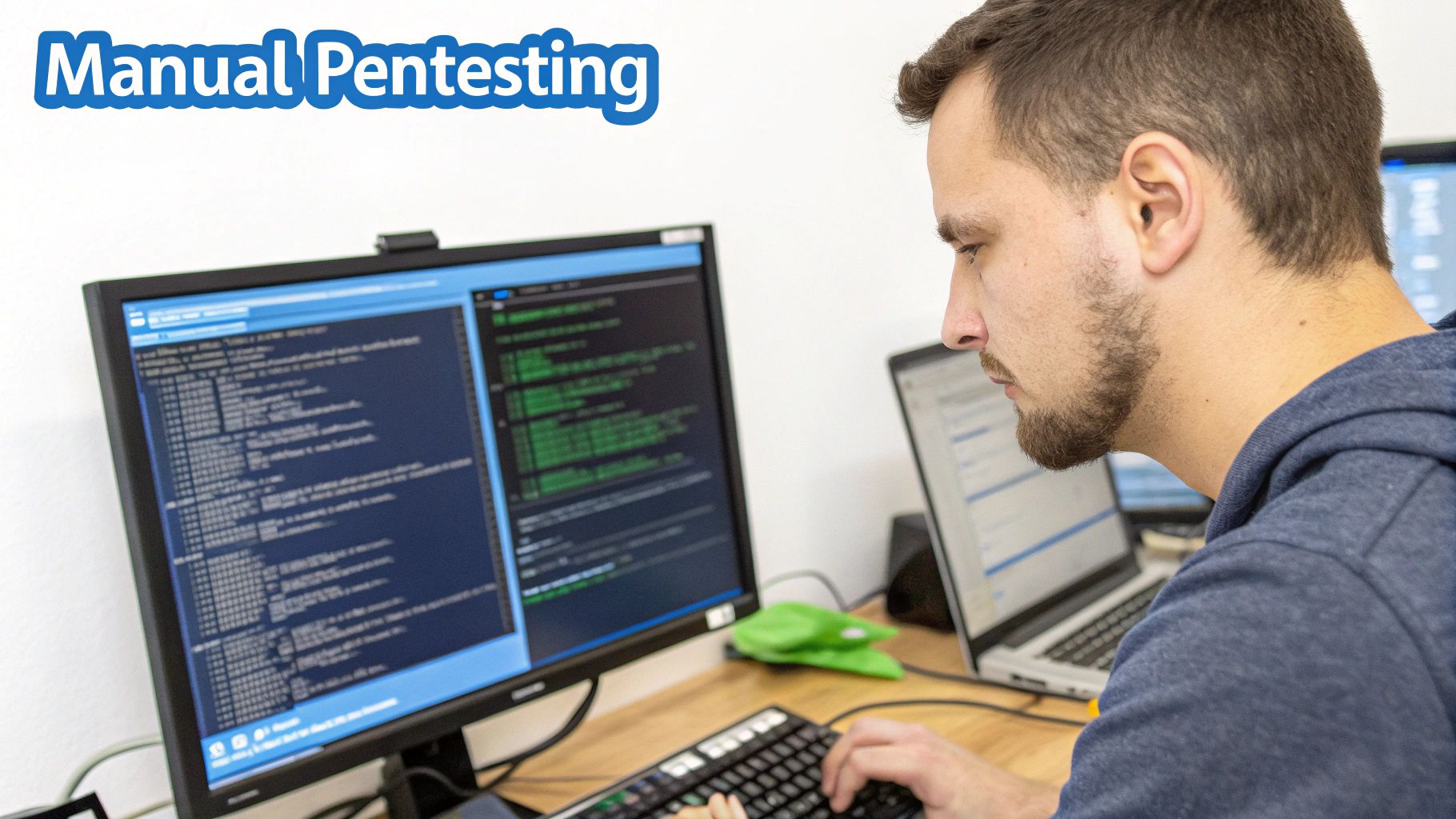A proper pen testing methodology is what makes a security assessment real, not just a simple vulnerability scan. Think of it as a structured game plan for finding and exploiting security holes. For MSPs and vCISOs, having a solid methodology is key to building client trust and meeting compliance for standards like SOC 2, HIPAA, and PCI DSS.
Why a Solid Pen Testing Methodology Matters

If you’re a Managed Service Provider, you’ve likely faced this problem. The penetration testing industry often has inflated prices, confusing testing methods, and long lead times. This creates major headaches for your clients who just want to meet audit requirements for PCI DSS or ISO 27001.
A real pen testing methodology isn't just a checklist; it's a battle plan that ensures every test is thorough and consistent. Without one, you’re just guessing. A structured approach means the assessment is complete, and you can repeat it later to show improvement. A great methodology is the perfect mix of standard frameworks and human creativity, allowing a skilled pentester to find risks automated tools will always miss.
Solving Problems in the Pentesting Industry
The traditional pentesting model is broken for the MSP channel. It’s often slow, overpriced, and your supposed partner can turn into a direct competitor. When you're building a security practice, the last thing you need is a vendor trying to steal your clients.
This is where a channel-only partner changes everything. Our entire business is built to support you—the MSP, vCISO, or GRC company. We deliver fast, affordable, and completely manual pentesting that you can offer as your own service. We are your partner, period. We never sell direct, so we never compete with our reseller clients.
How We Help Our Reseller Partners Succeed
We tackle the industry's biggest problems with a simple, partner-focused approach. Our team is made up of OSCP, CEH, and CREST certified pentesters who perform every test by hand. This human-led approach finds complex business-logic flaws that scanners can't, giving you a true risk assessment.
Our services are 100% white-labeled. You get a report and a process you can completely rebrand, which lets you own the client relationship and build your reputation as a security authority. By partnering with us, you can stop turning away pentesting opportunities and start satisfying compliance demands, becoming the trusted advisor your clients need. To learn more about building out your services, check out our guide on penetration testing best practices.
Understanding the Five Phases of Penetration Testing

Think of a professional penetration testing engagement like a heist movie. There's a plan, a crew, and a series of careful moves. A solid pen testing methodology follows a similar script, breaking the operation into five distinct phases so nothing is missed. This isn't about running a quick automated scan; it’s a meticulous, manual pentesting process where each step builds on the last.
This structured approach is how our certified OSCP, CEH, and CREST pentesters uncover vulnerabilities before a real attacker can. Here’s a quick overview of how a professional pentest breaks down into five key phases: planning, reconnaissance, exploitation, post-exploitation, and reporting. Each stage is critical for delivering a comprehensive and valuable security assessment.
Starting the Test with Planning and Scoping
Every good operation starts with a solid plan. In this first phase, we sit down with you being our reseller partner and your client to define the rules of engagement. We need to know exactly what’s in scope and what’s off-limits.
During this stage, we determine the objectives, such as satisfying SOC 2 or HIPAA compliance. We also define the scope by identifying which systems, networks, and applications are fair game. Finally, we agree on a clear timeline to ensure our fast turnaround hits your client's deadlines. Getting this right from the start ensures the test delivers exactly what your client needs for their risk assessment.
Gathering Intelligence Through Detailed Reconnaissance
With the plan set, it's time for reconnaissance. This is the intelligence-gathering phase where our pentesters act like detectives, piecing together clues about the target from public information. The goal is to find what an attacker would use to get a foothold.
This might mean digging up employee names, identifying software versions, or mapping out network IP ranges. The objective is to build a detailed map of the target's digital footprint without actually touching their systems. The more we find here, the more effective the next phases will be. A well-executed recon phase turns a blind attack into a targeted strike.
Finding Weaknesses with Manual Exploitation

This is the part everyone imagines when they hear "hacking." Armed with intel from recon, our testers actively try to exploit the vulnerabilities they’ve identified. This is where we attempt to gain unauthorized access to systems or data.
This is where the creativity of a certified pentester really shines. While we follow guides like the OWASP Top 10, our experts go much further, using custom scripts and creativity to find unique business logic flaws. It could be bypassing a login form or escalating a low-level user account to an administrator. The point is to prove a vulnerability is a real, exploitable risk.
Analyzing Impact During Post-Exploitation
Getting in is just the start. The post-exploitation phase answers the question, "Okay, we're in. Now what?" Our pentesters explore the compromised environment to figure out the real-world impact of a breach. They try to move across the network, hunt for high-value assets, and see how much sensitive data they can access.
This stage turns a simple vulnerability report into a true risk assessment. It shows the full potential damage an attacker could cause, which is what clients need to see to understand the urgency. For GRC firms and their clients working on ISO 27001 or PCI DSS, this evidence is critical. You can get a deeper look into the technical side by reading our article on how to perform penetration testing.
Delivering Actionable Reporting and Remediation Steps
This is arguably the most important phase. All findings from the test are compiled into a comprehensive, easy-to-read report. We don’t just list problems; we provide a detailed breakdown of each vulnerability, its risk level, and clear, actionable steps to fix it.
As a channel-only partner, we deliver this report to you as a white label pentesting document. You can brand it as your own and present it to your client, cementing your position as their trusted security advisor. Our reports are built to be useful for everyone, from the IT team to the executives, helping you guide your clients to a stronger security posture and nail their compliance goals.
Choosing the Right Penetration Testing Framework

If the five phases are the "what," then frameworks are the "how." A framework is like a specific playbook that guides the test. For MSPs and vCISOs, understanding these frameworks helps you have smarter conversations with clients when they face compliance requirements for SOC 2, HIPAA, or PCI DSS.
There are a few industry-standard frameworks, but you'll often hear about three: PTES for deep-dive risk assessments, NIST for government compliance, and OSSTMM for a holistic view of security. These frameworks didn't just appear out of nowhere; they were a direct response to rising cybercrime and regulatory pressure, making sure penetration testing became a systematic and measurable process. You can learn more about the history of pentesting frameworks and standards online.
Why Our Framework-Agnostic Approach is Better
So, which framework is the best? That’s the wrong question. A better question is, "Which framework fits what my client needs?" A rigid, one-size-fits-all approach doesn't work, which is why our pen testing methodology is framework-agnostic.
Our certified pentesters blend the best elements from multiple frameworks—like PTES, NIST, and OSSTMM—to build a test perfectly aligned with your client’s goals. This flexible approach is a huge advantage for our reseller partners. When your client needs evidence for a SOC 2 or ISO 27001 audit, we tailor the test to give auditors exactly what they’re looking for. It’s a custom-built risk assessment without the custom-built price tag.
Partner With Us For White Label Pentesting
A solid pen testing methodology is the foundation of a real security assessment. For MSPs and vCISOs, the best way to deliver these services is with a true channel-only partner. We built our business to solve the industry's biggest headaches: inflated prices, unreliable testing, and long lead times that kill deals.
We deliver fast, affordable, and completely manual penetration testing. Our team is filled with OSCP, CEH, and CREST certified experts. You can rebrand our reports and sell the service as your own, knowing we'll never compete with you. That’s our white label pentesting promise.
We empower you to meet client compliance demands for standards like SOC 2, HIPAA, PCI DSS, and ISO 27001. You become the trusted security advisor, building recurring revenue and strengthening client relationships. When you’re looking at partners, it makes sense to seek out providers of professional certified ethical hackers (CEH) services to ensure you have the right expertise.
Ready to offer fast, affordable, and expert manual pentesting to your clients? The team at MSP Pentesting is here to help you grow your security services without the headaches.
Contact us today to learn more about our white label partner program at https://msppentesting.com.



.avif)
.png)